
Original Link: https://www.anandtech.com/show/2731
NVIDIA GeForce GTS 250: A Rebadged 9800 GTX+
by Derek Wilson on March 3, 2009 3:00 AM EST- Posted in
- GPUs
In the beginning there was the GeForce 8800 GT, and we were happy.
Then, we then got a faster version: the 8800 GTS 512MB. It was more expensive, but we were still happy.
And then it got complicated.
The original 8800 GT, well, it became the 9800 GT. Then they overclocked the 8800 GTS and it turned into the 9800 GTX. Now this made sense, but only if you ignored the whole this was an 8800 GT to begin with thing.
The trip gets a little more trippy when you look at what happened on the eve of the Radeon HD 4850 launch. NVIDIA introduced a slightly faster version of the 9800 GTX called the 9800 GTX+. Note that this was the smallest name change in the timeline up to this point, but it was the biggest design change; this mild overclock was enabled by a die shrink to 55nm.
All of that brings us to today where NVIDIA is taking the 9800 GTX+ and calling it a GeForce GTS 250.
Enough about names, here's the card:

You can get it with either 512MB or 1GB of GDDR3 memory, both clocked at 2.2GHz. The core and shader clocks remain the same at 738MHz and 1.836GHz respectively. For all intents and purposes, this thing should perform like a 9800 GTX+.
If you get the 1GB version, it's got a brand new board design that's an inch and a half shorter than the 9800 GTX+:
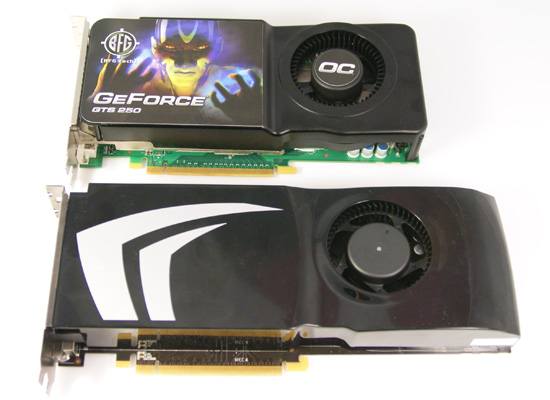
GeForce GTS 250 1GB (top) vs. GeForce 9800 GTX+ (bottom)
The new board design isn't required for the 512MB cards unfortunately, so chances are that those cards will just be rebranded 9800 GTX+s.
The 512MB cards will sell for $129 while the 1GB cards will sell for $149.
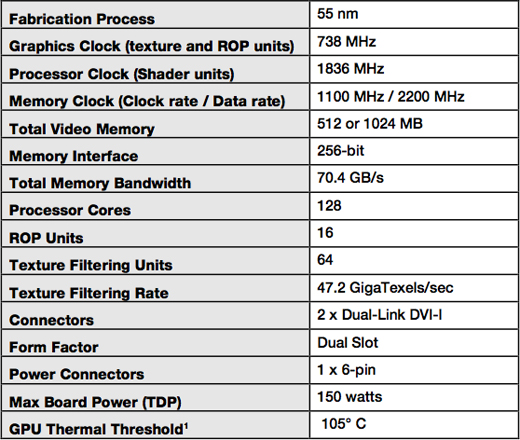
While the GPU is still a 55nm G92b, this is a much more mature yielding chip now than when the 9800 GTX+ first launched and thus power consumption is lower. With GPU and GDDR3 yields higher, power is lower and board costs can be driven down as well. The components on the board draw a little less power all culminating in a GPU that will somehow contribute to saving the planet a little better than the Radeon HD 4850.
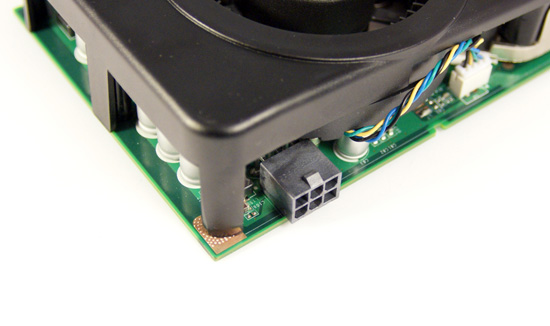
There's only one PCIe power connector on the new GTS 250 1GB boards
Note that you need to have the new board design to be guaranteed the power savings, so for now we can only say that the GTS 250 1GB will translate into power savings:

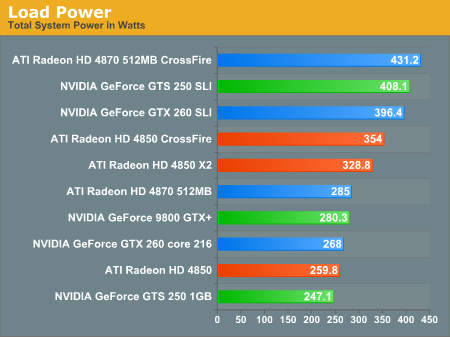
These are the biggest gains you'll see from this GPU today. It's still a 9800 GTX+.
Why NVIDIA Did It
To understand the motivation behind NVIDIA's naming and renaming and renaming we have to once again look its approach to GPU design. NVIDIA continued to architect very high end GPUs and allow their technology to, over the course of 9 - 12 months, trickle down to mid range and lower end market segments. AMD stepped in and launched a very competitive performance mainstream part instead of a high end GPU, allowing it to windfall down to lower price points and market segments quicker than NVIDIA could for this generation.
Let's attach some code names shall we?
NVIDIA's flagship, the GT200 GPU used in the GTX 295, 285, 280 and 260, isn't available in a cheaper version yet. AMD's flagship, the RV770, is already more affordable and is available in cheaper versions. NVIDIA has to rely on its last generation GPU, the G92b, to compete in the rest of the market while the lower end GT200 derivatives get ready for production. Rather than continue to ship products with old names to vendors and customers, NVIDIA slaps a new name on an old GPU and hopes to at least provide the appearance of being just as agile and competitive as AMD despite being clearly caught off guard this generation.
Of course, NVIDIA has a case to make. This is their current generation of hardware, and it is practical and useful to maintain a consistent nomenclature so that the general public knows what the product positioning actually is. We agree, only our solution is top to bottom launches in line with new GPU architectures rather than simply changing the name of old parts so that they look shiny and new.
NVIDIA's take on this is also flawed in that it treats customers like idiots and underlines the fundamental issue we have. Do I need a card with a new name on it to believe that it is worthy of my purchase, or can I go read reviews comparing the hardware and learn for myself whether or not any card (regardless of the name) fills my need? Maybe this name change is for people who don't know anything about graphics hardware then. In that case the thing that "sells" the card is the simple fact that NVIDIA has convinced someone that this part is an affordable version of a card from their latest line of products. Saying they need a name change to maintain current naming is essentially admitting that the only reason the name needs to be changed is to mislead uninformed people.
NVIDIA would love to have 40nm GT200 derivatives out today. Until that day comes, we'll get cards that sound like GT200 based products.
Anyway, we haven't previously tested a 1GB 9800 GTX+, and until this announcement their prices haven't been anywhere near reasonable (currently they're up at $200, so the $50 price drop will make a big difference). There is also a slight tweak between the GTS 250 1GB and the 9800 GTX+ 1GB: the memory on the 1GB 9800+ was underclocked by about 9.1%, and the GTS 250 1GB brings clock speed back in line with the 512MB 9800 GTX+. So while the 512MB part doesn't perform any different in any way, we should no longer see any performance degradation in games that don't benefit from memory size but are memory bandwidth sensitive from moving up to 1GB.
Oh, also wide availability won't be until March 10th. Seriously.
Also, not explained until now is the way the new naming scheme will go forward. Now, GTX, GTS, GT and G (as far as we can gather) will indicate performance segment. The number will be the model number and within a performance segment, higher is better. Essentially NVIDIA has swapped the meaning of letters and numbers in their naming. They have also clearly told us that naming will no longer be attached to GPU architecture, but that vendors may somehow still indicate architecture on the box if they so choose. If nothing else, the feature list and specifications will be a guide. Here's to requiring that people read the fine print to know what they're buying.
For What it's Worth
Early last week Charlie over at The Inquirer posted a story saying that a number of reviewers were cut out of the GeForce GTS 250 launch. We felt a bit hurt, by the time the story launched we weren't even asked to be briefed about the GTS 250. Cards had already gone out to other reviewers but we weren't on any lists. Oh, pout.
Magically, a couple of days after Charlie's article we got invited to a NVIDIA briefing and we had a GTS 250 to test. Perhaps NVIDIA was simply uncharacteristically late in briefing us about a new GPU launch. Perhaps NVIDIA was afraid we'd point out that it was nothing more than a 9800 GTX+ that ran a little cooler. Or perhaps we haven't been positive enough about CUDA and PhysX and NVIDIA was trying to punish us.
Who knows what went on at NVIDIA prior to the launch, we're here to review the card, but for what it's worth - thank you Charlie :)
More From CeBIT: New Mobile Parts
Unfortunately, we were unable to get any notebooks with these new GPUs to test them out before we tell you about them, but both NVIDIA and AMD are announcing new mobile GPUs today.
NVIDIA's move parallels what's happening on the desktop in that the newest additions to the mobile line up are 55nm G92 based parts with names in the new style NVIDIA has chosen. Actually, the entire lineup of 9xxxM series parts is being replaced by parts with new names. This is certainly more expected on the mobile side, as we usually do see much more lag in this space than on the desktop.
As for the specifics, the new parts are the top of the line models. The GTX 280M will be up to 50% faster than the 9800M GTX, which is nice in theory, but final performance will still be up to notebook makers who will set the final clocks on the part on a per notebook basis to accommodate their power budget. The GTX 260M is one step down from the 280M in that it has 112 SPs enabled (like the original G92 introduced as the 8800 GT) and lower maximum clock speeds.
These two high end GTX parts replace the top end 9800M parts, and subbing for the 9800M GS is the GTS 160M which will also offer improved performance, although we didn't get full specifications on this part. Rounding out the bottom of the lineup are the GT 130M and the G 110M.
On the AMD front, we see something a little more intriguing in the form of the first 40nm GPUs in the mobile space. Smaller die sizes, lower power and better power are promised, though the general naming will stay the same for AMD. The new 40nm 4800 series parts can be paired with either DDR3, GDDR3, or GDDR5; the choice is up to the notebook maker. AMD touts the fact that they can get about double the processing power in the same area with their new process, which will only benefit them going forward.
NVIDIA paints the GDDR5 option as overkill, but we really won't know about performance of either the new NVIDIA or AMD parts until we have hardware to test.
The NVIDIA and AMD supplied relative performance graphs are nearly useless in sorting out how these parts should compare to each other, so we'll really have to save the head to head for a time when we have hardware on our hands. 40nm could be a big plus for AMD, but remember that NVIDIA has made the first move in making mobile drivers available from their web site. The value of that is very high, as notebook OEMs tend not to like updating their drivers very often. Sure, it's possible to hack desktop drivers onto a mobile part, but it is a supreme headache and we hope AMD will soon follow in NVIDIA's footsteps with this move.
Back to the Tests at Hand
Now that we've covered all the announcements and introductory material, let's get to testing the hardware we've got in our hot little hands.
We got our card just a couple days ago, so we haven't had time to test everything, and we've only received one card so we haven't been able to test SLI with the 1GB version. We would also have added to our benchmarks by including 1280x1024 in our tests if we had had the time. This is a very important resolution for this class of hardware, but 1680x1050 should be a good enough indicator of relative performance in most cases so that this won't matter too much.
Our comparisons will be a little lop sided though. We've got two each (for single and dual configurations) of the 512MB 4850 and the 512MB GTS 250 (the 9800 GTX+). These comparisons we can do, and it's nice and neat as both parts are now set at a $130 (cutting recent street prices by about $15). We do have a GTS 250 1GB, but we don't have a 1GB 4850 to compare it to. On the flip side, since we've only got 1 GTS 250 1GB, we can't compare GTS 250 1GB SLI to the 4850 X2 2GB we have.
The test setup hasn't changed for this article, except that we've had to use the 182.08 for the GTS 250 1GB.
| Test Setup | |
| CPU | Intel Core i7-965 3.2GHz |
| Motherboard | ASUS Rampage II Extreme X58 |
| Video Cards | Sapphire ATI Radeon HD 4850 X2 2GB ATI Radeon HD 4870 512MB CrossFire ATI Radeon HD 4850 CrossFire ATI Radeon HD 4870 512MB ATI Radeon HD 4850 NVIDIA GeForce GTX 260 SLI NVIDIA GeForce 9800 GTX+ SLI NVIDIA GeForce GTX 260 core 216 NVIDIA GeForce GTS 250 1GB NVIDIA GeForce 9800 GTX+ |
| Video Drivers | Catalyst 8.12 hotfix ForceWare 181.22 |
| Hard Drive | Intel X25-M 80GB SSD |
| RAM | 6 x 1GB DDR3-1066 7-7-7-20 |
| Operating System | Windows Vista Ultimate 64-bit SP1 |
| PSU | PC Power & Cooling Turbo Cool 1200W |
Age of Conan Performance
NVIDIA hardware sweeps this benchmark with the GTS 250 remaining playable all the way up to 2560x1600 while the 4850 can't hold on past 1920x1200. As there is very little difference between the both the GTS 250 / 1GB and the 4850 CrossFire / X2, it doesn't seem like a 1GB 4850 would help very much here either.
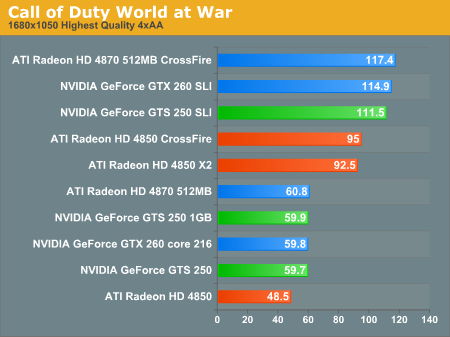
1680x1050 1920x1200 2560x1600
Crysis Warhead Performance
This one is pretty interesting even though our multiGPU options are system/LOD limited by the game at 1680x1050 and 1920x1200. It's clear that memory really helps in this test when resolution increases, as the 1GB GTS 250 improves on the 512MB by about 50%. At lower resolutions, the GTS 250 1GB just comes in ahead of the 512MB 4850 which just comes in ahead of the 512MB GTS 250. It looks like at 1680x1050 and lower the memory stops making a difference and all three of these cards just tie.
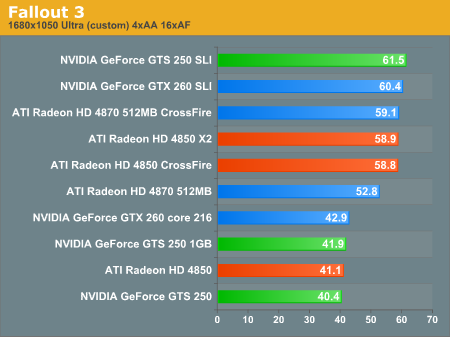
1680x1050 1920x1200 2560x1600
FarCry 2 Performance
Across the board in this benchmark the Radeon 4850 leads both the GTS 250. The GTS 250 1GB catches up at 2560x1600 though. It does seem, however, that SLI scales better in this benchmark, and the GTS 250 1GB in SLI might post some decent numbers at 2560x1600 as well.
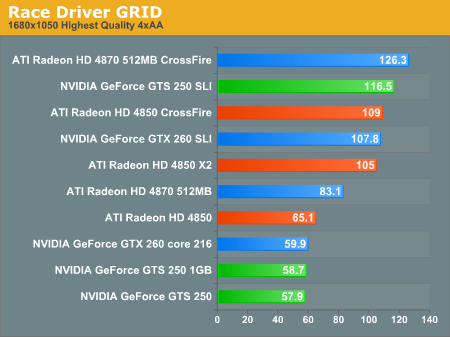
1680x1050 1920x1200 2560x1600
Final Words
If we focus on what is likely to be the target resolution of 1680x1050, the Radeon HD 4850 ties its direct competition, the GTS 250 512MB, the Radeon HD 4850 leads more often than it trails or loses. The 1GB GTS 250 does edge out the 4850 in one more benchmark, but it does cost $20 more and we haven't tested the 1GB 4850 which might make the difference.
We've recommended the 4850 over the 9800 GTX+ in the past, and we'll continue to do so now that it's called the GTS 250. But the extra memory does help out, especially if the card is to be used for 1920x1200 on a budget (or maybe with an HDTV).
Power consumption is an advantage the GTS 250 1GB holds. The new board design is only required on the 1GB model, and board vendors may opt for the new design on their 512MB parts, but they may also stick with their current 9800 GTX+ designs. We expect that at first the 512MB GTS 250 will more closely resemble the 9800 GTX+. This does mean we are left with the oddity of the 1GB part drawing less power than the 512MB part for now. Once we get a 512MB version with the new board revision we'll have to take another look at power draw.
The GTS 250 1GB is a better option than it's 512MB brother, and it's also a better option than the 4850 based on our tests. It isn't a game changing difference, but its an edge nonetheless. Is the added performance worth the extra $20? That has to come down to the individual gamer.
UPDATE: We are hearing rumblings of a price drop for the Radeon HD 4870 512MB to $150, and if this happens, there will be no contest between the two. AMD will handily lead at the $150 price if they can get their partners to adjust the price down this much. But doing this would also eat into the market for the 4850, as the jump in value for the extra money would be way more than worth it. Spending $150 over $130 (for either the 4850 or GTS 250) and getting the performance jump from the 4870 is just a no brainer. With the extra RAM, not even the 1GB GTS 250 can compete with the 4870, so IF we see the price adjustment THEN the GTS 250 1GB will be a non-starter. Without this price adjustment, our conclusion stands as is.







